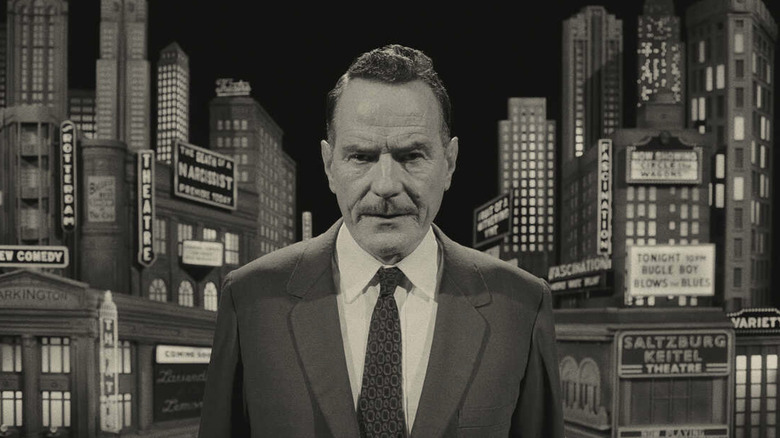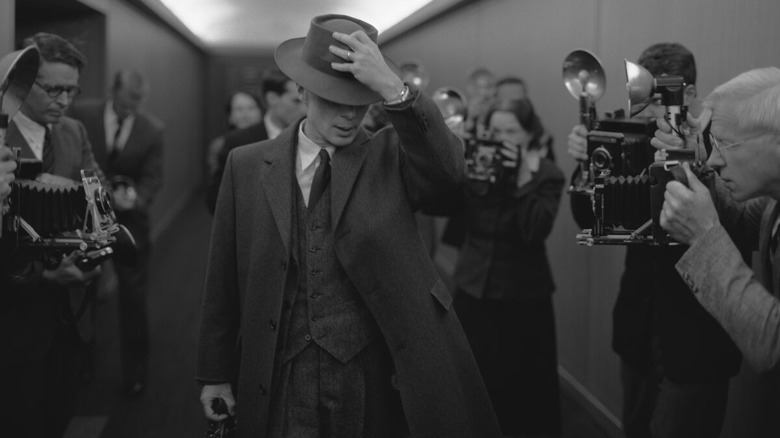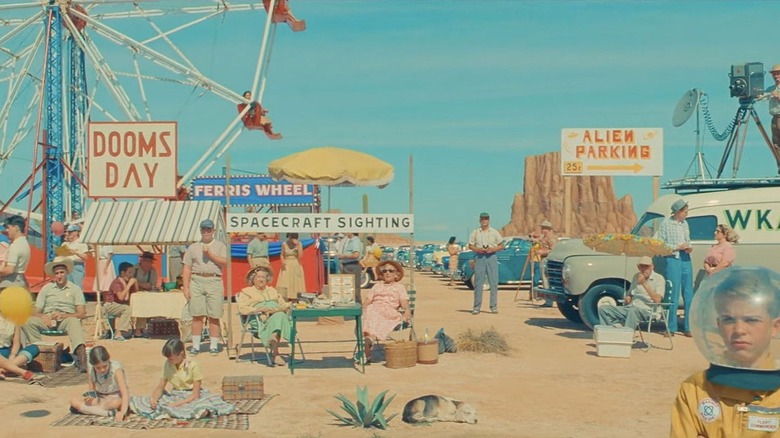Asteroid City Is Stealing Some Of Oppenheimer's Thunder
Wes Anderson's new film "Asteroid City" is a meta-narrative sci-fi dramedy about ... I think ... the power an author's personal life tends to exert itself over their creative output. Even if someone is writing a story about ray guns, aliens, and the frustrations of quarantine, they will ultimately be writing a story about themselves and their own anxieties. It's explained in an introduction that "Asteroid City" is the idealized version of a stage play, written by a celebrated playwright decades before, and long since passed into posterity. Characters will exit the film and transform into mere actors backstage where they will confront the playwright about the play's meaning. He cannot give an adequate answer. The final message of the film is the rather meaningless refrain of "You can't wake up if you don't fall asleep."
Notably, the "real life" sequences are in black and white, while the fantasy sequences are in vibrant, Radiator Springs color.
Most of "Asteroid City" is unique, standing apart in content even from other Wes Anderson movies. There are, however, multiple aesthetic similarities between "Asteroid City" and Christopher Nolan's upcoming biographical movie "Oppenheimer." Indeed, because "Asteroid City" was released first, one might be tempted to suggest that Nolan had borrowed ideas from his forbear. If one were so inclined, one might even become bold and begin to assert that "Oppenheimer" wouldn't exist were it not for "Asteroid City." If one were so inclined, of course.
Let us look at the many similarities between the two films and surmise what we shall surmise, shall we? Surmise we shall.
The setting
Both films are set in 1955. "Asteroid City" employs the aesthetics of a chintzy hotel lobby that hasn't been updated since the 1950s, employing a lot of cowhide/denim textured among its rounded sci-fi structures and buzzing ray guns. "Oppenheimer," meanwhile, doesn't have the cowboy aesthetic, but does indeed focus on the hefty, metallic technology of the time. Anderson's film uses an exaggerated version of 1955 technology, while Nolan's uses some of the actual, advanced technology of the time. Regardless, they are most definitely drawing from the same creative pool.
Additionally, both films use color and black-and-white similarly, using the former to depict a heightened version of reality, and the latter to show how grounded things are. Color is fancy, black-and-white has grit. The more difficult thematic notions of "Asteroid City" come during the black-and-white segments. One might assume something similar will come from "Oppenheimer."
And, yes, both films are about nuclear bombs. "Oppenheimer" is about J. Robert Oppenheimer (Cillian Murphy) one of the theoretical physicists that developed the nuclear bomb. If the preview is any gauge, "Oppenheimer" will feature multiple outsized bomb blasts.
The titular city in Anderson's film, meanwhile, is located in the middle of the desert, not terribly far from where nuclear bombs are being tested. At the start of the film, a mushroom cloud appears in the background, and the despondent photographer Augie Steenbeck (Jason Schwartzman) takes a picture of it. Total nuclear annihilation, while not a central plot point of "Asteroid City," remains hovering over the proceedings at all times.
Indeed, the same is true of "Oppenheimer."
Other parallels
Why are these two filmmakers choosing to focus on nuclear bomb technology in America in the mid-1950s? As it so happens, both Nolan and Anderson are about the same age. Nolan was born at the end of July 1970, while Anderson was born in May 1969. Although they grew up in different countries (Nolan in England and Anderson in the United States), they followed similar creative trajectories. Anderson released his first feature, "Bottle Rocket" in 1996, and it was about quirky outsiders who dreamed of being criminals. Nolan released his first feature, "Following" in 1998, and that film was about outsiders who followed strangers and infiltrated their lives via break-ins. It's also about aspiring criminals seeking identity.
To date, Nolan has made 12 films, and Anderson has made 11. They have both made films about stage performers ("Rushmore," "The Prestige"), and they have both made movies set in a ruined near-future ("Isle of Dogs," "Interstellar"). Nolan made three movies about a man who dresses like a bat. Anderson made a movie about a man who is a fox. In "The Grand Budapest Hotel," Anderson carefully constructed and manipulated architecture. In "Inception," Nolan used special effects to alter the skyline of a major city.
All told, Anderson's films have received 15 Academy Award nominations while Nolan's have received 34. That's about the same, though, because Anderson's nominations count double for some reason, and "Tenet" doesn't count for some reason. Anderson also made a film about a man who works underwater ("The Life Aquatic with Steve Zissou") and most of Nolan's characters sound like their dialogue was recorded underwater. I'm kidding ... or am I?
What we're saying is, these movies are practically identical and the two filmmakers are clearly the same person. Come to think of it, I've never seen them photographed together ...
"Asteroid City" is currently playing in theaters while "Oppenheimer" arrives on July 21, 2023.


